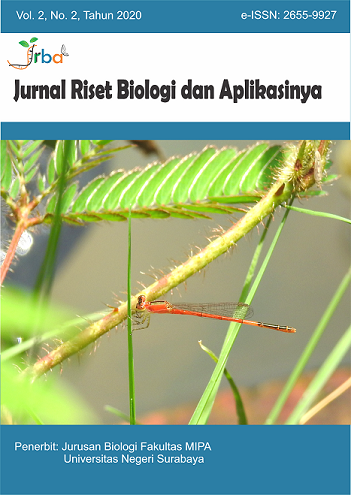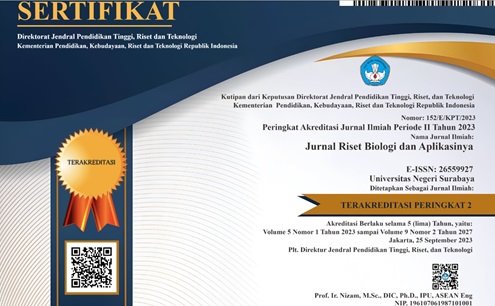Addition of Carbon Sources to Pineapple Waste Media in the Production of Single Cell Protein Biomass Saccharomyces cerevisiae
DOI:
https://doi.org/10.26740/jrba.v2n2.p70-76Keywords:
Fermentation, pineapple peel, single cell protein, saccharomyces cerevisiaeAbstract
Single-cell protein (SCP) is the term used for crude or pure protein derived from simple single or multi-celled microorganisms. Pineapple peel contains monosaccharides as much as 10.8% so that it can be used as a fermentation medium in single-cell protein production. The purpose of this study was to determine the effect of adding carbon sources of fructose and sucrose on pH, cell dry weight, and protein content in the manufacture of single-cell proteins. This study used a completely randomized design (CRD) with two factors, namely the addition of carbon (fructose, sucrose, and control) and fermentation time (24.48, and 72 hours). The data analysis used the variance test and the Duncan Multiple Range Test (DMRT) continued to test with a confidence level of 95%. The results showed that the addition of carbon to the media had a very significant effect on media pH, cell dry weight, and protein content. In the medium with the addition of fructose it has a pH of 3.81; dry weight 0.4203 grams; and protein content 69.08/L. Whereas in the media with the addition of sucrose, the pH was 4.33, the dry weight of the cells was 0.3385 grams, and the cells had a protein content of 85.55 mg/L. The addition of a fructose carbon source gave the cell dry weight more than the addition of carbon sucrose
References
AOAC. (1995). Official Methods of Analysis of The Association of Official Analytical Chemists. Washington DC: Association of Official Analytical Chemists. https://www.aoac.org/
Artiyani, A. (2011). Bioetanol dari Limbah Kulit Singkong Melalui Proses Hidrolisis dan Fermentasi dengan Saccharomyces cerevisiae. Prosiding Seminar Nasional Manajemen Teknologi XIII. http://eprints.itn.ac.id/2911/1/01.
Azizah, N., Al-bAARI, A., & Mulyani, S. (2012). Pengaruh Lama Fermentasi Terhadap Kadar Alkohol, pH, dan Produksi Gas pada Proses Fermentasi Bioetanol dari Whey dengan Substitusi Kulit Nanas. Jurnal Aplikasi Teknologi Pangan, 1(2), 7277. http://jatp.ift.or.id/index.php/jatp/article/view/73.
Babazadeh, M., Soltani, M., Kamali, A., & Asl, M. S. (2014). Production of single cell protein from Stickwater of kilka fish meal factory using Lactobacillus plantarum and Bacillus licheniformis. Iranian Scientific Fisheries Journal, 19(4): 96101. http://aquaticcommons.org/id/eprint/21797.
Casselman, R. (2004). Yeast Propagation and Maintenance : Principles and Practices by MB. : California: The maltose falcons. https://www.semanticscholar.org/paper/Yeast-Propagation-and-Maintenance-%3A-Principles-and-Raines Casselman/e5e8ea0b5a6e5bc0d41a3cec881e26a84d0e4d6c.
Dhanasekaran, D., Lawanya, S., & Saha, S. (2011). Production of Single Cell Protein From Pineapple Waste. Innovative Romanian Food Biotechnology, 8, 2632. https://www.researchgate.net/publication/235354886_Production_of_single_cell_protein_from_pineapple_waste_using_yeast
Febriyanti, A. E., Sari, C. N., & Adisyahputra, A. (2017). Efektivitas Media Pertumbuhan Khamir Komersial (Saccharomyces Cerevisiae) Untuk Fermentasi Bioetanol Dari Eceng Gondok (Eichhornia crassipes). Bioma, 12(2), 112. https://doi.org/10.21009/bioma12(2).6
Masithoh, E., & Nim, M. (2012). Pengaruh Konsentrasi Sukrosa Terhadap Pertumbuhan Khamir Roti Saccharomyces Cerevisiae Pada Media Bekatul Dalam Produksi Protein Sel Tunggal [Universitas Sebelas Maret].https://digilib.uns.ac.id/dokumen/detail/28307/Pengaruh-Konsentrasi-Sukrosa-Terhadap-Pertumbuhan-Khamir-Roti-Saccharomyces-Cerevisiae-pada-Media-Bekatul-dalam-Produksi-Protein-Sel-Tunggal.
Mondal, A.K., Sengupta, S., Bhowal, J., & Bhattacharya, D.K. (2012). Utilization of Fruit Wastes in Producing Single Cell Protein. International Journal of Science, Environment and Technology, 1(5), 430438. http://www.ijset.net/vol-5/1/IJSET%209.pdf.
Nastiti, U. N., Lastuti, N. D. R., & Nurhajati, T. (2013). The decreasing of crude fiber and the increasing of crude protein content of pineapple peel (Ananas comosus L. Merr) which fermented by cellulolytic bacteria (Actinobacillus sp. ML-08). Agroveteriner, 1(2), 4654.http://journal.unair.ac.i/AGROVET@the decreasing-of-crude-fiber-and-the-increasing-of-crude-protein-content-of-pineapple-peel-(ananas-comosus-l.-merr)-which-article-6803-media-49-category-5.html.
Pawignya, H. (2011). Pembuatan Protein Sel Tunggal dari Limbah Nanas dengan Proses Fermentasi. Prosiding Seminar Nasional Teknik Kimia 'Kejuangan". Pengembangan Teknologi Kimia Untuk Pengolahan Sumber Daya Alam Indonesia, A05-1-A05-5. https://www.academia.edu/34661948/Pembuatan_Protein_Sel_Tunggal_dari_Limbah_Nanas_dengan_Proses_Fermentasi.
Pratiwi, L. D. (2018). Kajian Kinetika Pertumbuhan Mikroorganisme Dan Kandungan ?-Glukan Selama Fermentasi Tempe Dengan Penambahan Saccharomyces Cerevisiae. Lampung: Universitas Lampung. https://onesearch.id/Record/IOS4198.31796.
Purwitasari, E., Pangastuti, A., & Setyaningsih, R. (2004). Pengaruh Media Tumbuh terhadap Kadar Protein Saccharomyces cerevisiae dalam Pembuatan Protein Sel Tunggal. Bioteknologi, 1(2), 3742. https://doi.org/10.13057/biotek/c010202.
Purwanto, Maria G. M. (2014). Perbandingan Analisa Kadar Protein Terlarut dengan Berbagai Metode Spektroskopi UV-Visible. Jurnal Sains & Teknologi, 7, 2: 64-71. http://repository.ubaya.ac.id/24502/2/Purwanto_Perbandingan%20Analisa_2014.pdf.
Reed, G. & Nagodhawithana, T.W. (1988). Technology of yeast usage in winemaking. American Journal Enology Viticology, 39, 83-85. https://www.ajevonline.org/content/39/1/83.
Septriani, E. E. (2009). Isolasi dan Identifikasi Saccharomyces cerevisiae yang Diperoleh dari PG-PS Madukismo Yogyakarta yang Digunakan dalam Proses Fermentasi Alkohol [Yogyakarta]. https://repository.usd.ac.id/17106/2/058114148_Full.pdf.
Srividya, A.R., Vishnuvarthan, V.J., Murugappan, M & Dahake, P. G. (2014). International Journal for Pharmaceutical Research Scholars (IJPRS). International Journal for Pharmaceutical Research Scholars (IJPRS), 2(I4), 671677. https://www.researchgate.net/publication/259694702_Single_cell_Protein-_A_Review.
Suman, G., Nupur, M., Anuradha, S., & Pradeep, B. (2015). Single Cell Protein Production: A Review. International Journal of Current Microbiology and Applied Sciences, 4(9), 251262. https://doi.org/10.1016/S0167-8760(01)00179-9
Tahir, I., Sumarsih, S., & Astuti, S. (2008). KAJIAN Penggunaan Limbah Buah Nenas Lokal (Ananas. Makalah Seminar Nasional Xviii, Jurusan Kimia FMIPA UGM. Https://Www.Academia.Edu/25998288/Kajian_Penggunaan_Limbah_Buah_Nenas_Lokal_Ananas_Comosus_L_Sebagai_Bahan_Baku_Pembuatan_Nata_Fruit_Waste_of_Local_Pineapple_Ananas_Comosus_L_as_Nata_Media
Wardani, A. K., Nurtyastuti, F., & Pertiwi, E. (2013). Produksi Etanol Dari Tetes Tebu Oleh Saccharomyces Cerevisiae Pembentuk Flok (Nrrl-Y 265) Ethanol Production From Cane Molasses By Flocculant Saccharomyces Cerevisiae (Nrrl-Y 265). Agritech, 33(2), 131139. https://doi.org/https://doi.org/10.22146/agritech.9810.
Widanti, A. (2012). Produksi Protein Sel Tunggal Dari Limbah Cair Tahu Dengan Kultur Saccharomyces cerevisiae 3005. Yogyakarta: Universitas Islam Negeri Sunan Kalijaga. http://digilib.uin suka.ac.id/id/eprint/10791.
Wijaya, A. I. P. (2013). Kadar Protein dan Organoleptik pada Berbagai Macam Tempe dengan Variasu Bahan dari Koro Pedang (Canavalia ensiformis L. DC) dan Kedelai (Glycine max (L.) Merr). Salatiga: Universitas Kritsten Satya Wacana. https://repository.uksw.edu/bitstream/123456789/4677/2/T1_652009016_Full%20text.pdf.
Downloads
Published
How to Cite
Issue
Section
 Abstract views: 1290
,
Abstract views: 1290
, PDF Downloads: 2024
PDF Downloads: 2024












